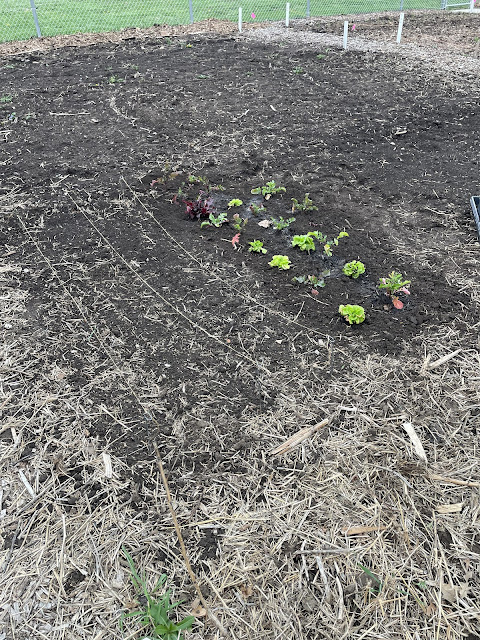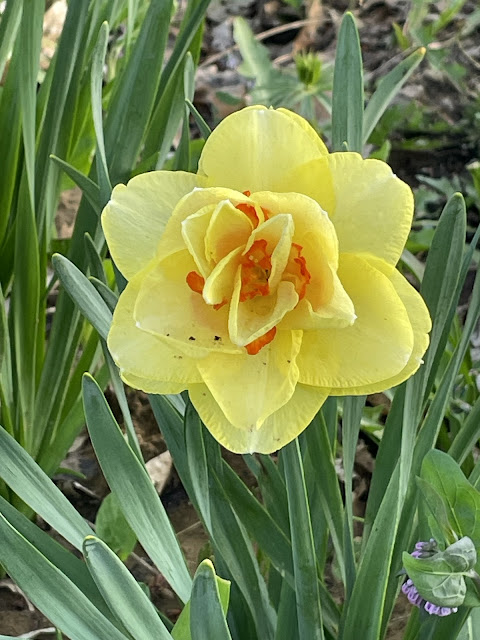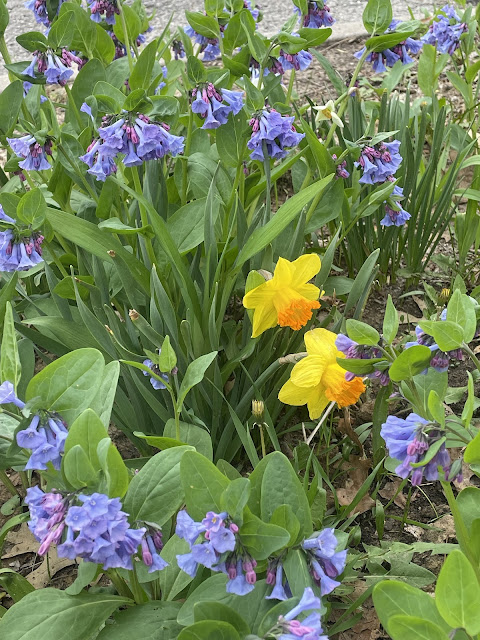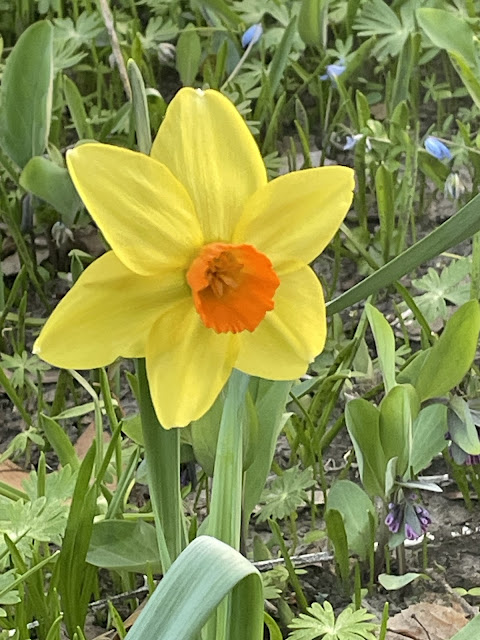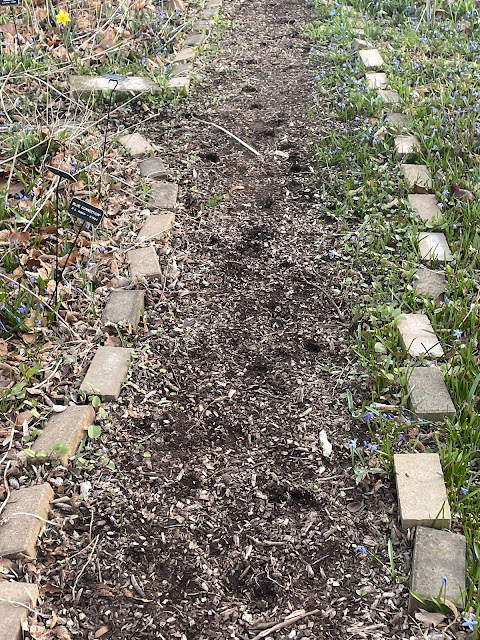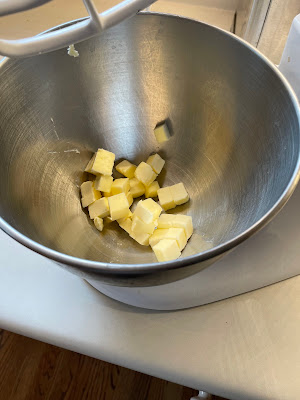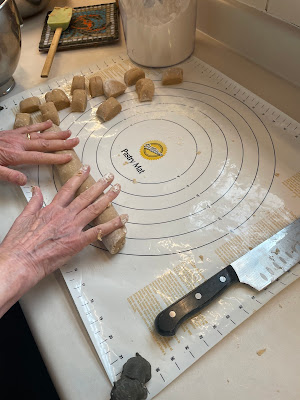It is bluebell time. And with a little moisture and cool weather the bluebells should last a while.
Yesterday was a wonderful day for gardening. It was in the 50's, and was mostly overcast. We had several small rains earlier in the week which meant things did not seem too dry.
In fact the sunny garden plot opened a little early this year. I went over Wednesday, after work and planted beets, arugula, and spinach. I knew some rain was coming, and it came. To add to the early vegtable trio, I then took over the smaller pots of lettuce, adding them to the 1/3 of the plot that is now planted.
Digging up plants for the foof bank sale is in full swing. I potted cristata iris, and some blackberry lilies (which are really an iris.) I already had cyress spurge, baptista, celendine poppies, and other dwarf iris.
I potted up some Montana hosta. It brought back memories. I first started potting up hosta from the garden about 40 years ago. Because of deer I did spray the pots, now sitting in the back driveway. That is right near the deer path. I also went around the garden spraying Plantskydd on all the hosta. (You do not have to worry much until the hosta leaf bursts open.)
I had the usual gardening rotation of potting something, raking the last of the leaf places, and just to show there was not enough work to do, I started digging dandilions.
The little dwarf iris started this week. There were about 7-8 varities blooming this weekend, including the two iris in the featured pictures from this week.
Last Week
In a close contest the hellebore came out ahead.
This Week
I have another vote for you.
#1 Black Hellebore
#2 Little iris with bluebells
#3 Daffodil Tahiti
#4 Little white iris with blue beard
#5 Daffodils with bluebells
#6 White daffodil with red center
It has been a good season for daffodils. That means it has been cool. Now the bluebells have joined them, and with some rain today the garden will be at its peak.
Right Now
Not all pictures can be featured. Here are some of the rest.
Regularl bluebells actually start out pink.
The clumps of daffodils are good this year. The fact we have not had any hard rains helps. A hard rain can splash on the daffodils which does not make for good pictures.
The double daffodils are mostly late blooming.
The epimedium are blooming. This is Cherry Tart.
This plant was responsible for an "oh my" yesterday. I knew I had at least a dozen tree peony seedlings. I had no idea that this one had a bud. The other two seedlings that I thought might bloom, fizzled. But there this one was and it certainly has a bud.
This is the white bluebell. It is a rare nutation that to the best of my knowledge is not available in commerce.
The dogwood is about to bloom.
Julia's recipe
Applesauce pie
I was thinking about applesauce the other day. The occasion was the imminent delivery of half a pig. We buy half a pig every year or so from a farmer we know. It is processed at a meat locker in Sully, Iowa which some of you may recall as part of the twin cities of Lynnville and Sully west of Grinnell. I needed to make room in the freezer. I make and freeze applesauce during apples-at-the-farmers-market season, and I had some still in the freezer. So I thought why not make applesauce pie? There's pumpkin or squash pie, so why not use applesauce instead of pumpkin puree? I was not prepared to wing it, and I found a recipe on the internet website "Food.com."
The ingredients:
1 9" pie crust;
2 eggs;
1 cup sugar;
1/2 cup (1 stick) butter, melted;
2 tablespoons flour
1 teaspoon vanilla;
2 tablespoons lemon juice; and
1 cup thick applesauce.
Philip made me a piecrust. I prebaked it sort of. I baked the empty piecrust (lined with a piece of foil and weighted down with dried beans) in a 350 oven for about 10 minutes. Then I took it out of the oven. I took the foil and beans out of the piecrust, and I pricked the bottom of the crust with a fork 20 times or so. And I put it back in the oven for another 10 minutes. At that point, the crust was pale tan and had shrunk a bit.
The point is to avoid the dreaded soggy crust. Pricking the bottom may seem counterproductive. But it works and pricking the crust keeps it from ballooning up in the second 10 minutes of baking (which the weights had done earlier on).
Okay. Next a word about applesauce. Homemade applesauce is usually thinner than commercial. So I poured my applesauce (about 2-1/2 cups to begin with) into a mesh strainer that was resting on top of a small mixing bowl. I stirred the applesauce around and let it drip. I ended up with 1 cup of thick applesauce and 1-1/2 cups of pretty tasty apple juice. So whatever kind of applesauce you're using, use a mesh strainer over a bowl to allow any liquid to drain.
With the piecrust out of the oven and the applesauce strained, it was time to put it all together.
I put the eggs, sugar, flour, vanilla and lemon juice in a mixing bowl.
Then I added the applesauce and whisked it all together.
I melted the stick of butter and let it cool for 10 minutes.
I whisked the butter in and the filling was done.
I use salted butter, so I did not add any salt. If you use unsalted butter, add a little salt - maybe 1/8 teaspoon.
Into the piecrust. I always bake pies with a rimmed baking sheet underneath. In case of drips and for ease of getting the pie in and out of the oven.
I baked the pie at 350 degrees for about 40 minutes. I started testing for doneness after 30 minutes. If it makes little waves when you pull the baking sheet out, it's not done.
But it may not be fully set when it is done. Use a knife to test. If a knife stuck in the middle of the pie comes out wet but without any goop, it's done. If there's goop on the knife, it's not quite done.
The filling will set beautifully as the pie cools.
Out of the oven. After the pie had cooled to room temperature, it sliced into neat pieces. It was good with a scoop of vanilla ice cream or plain. I think it would be great with a dollop of whipped cream, like pumpkin pie.
Philip says we should add it to the Thanksgiving array. And he's right.
Odds and Ends
We have deer. We have rabbits. We have the occasional duck. We do not have giant rodents. Do you know about capybaras?
https://www.nytimes.com/2025/04/17/world/americas/argentina-capybaras-vasectomies.html
The garden is a great escape. As I dig the dandelions I do not think about war or other ways people are not getting along. The list of things I do not think about is long.
I help feed people. At my day job I try to lift burdens on my clients.
But I often ask myself if that is enough.
This country is in a lot of trouble, and it is not just the price of eggs.
The annoying columnist David Brooks just wrote this...in a public column.
"It’s time for a comprehensive national civic uprising. It’s time for Americans in universities, law, business, nonprofits and the scientific community, and civil servants and beyond to form one coordinated mass movement. Trump is about power. The only way he’s going to be stopped is if he’s confronted by some movement that possesses rival power."
Happy Easter
Pray for peace.
Philip












